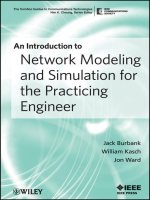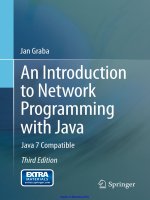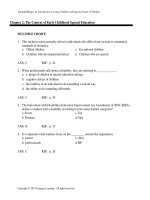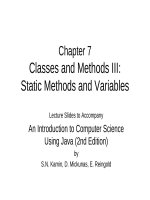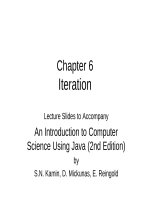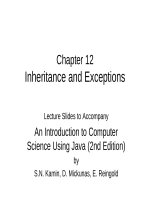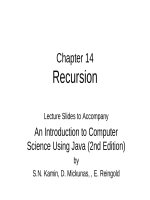an introduction to network programming with java
Bạn đang xem bản rút gọn của tài liệu. Xem và tải ngay bản đầy đủ của tài liệu tại đây (3.55 MB, 389 trang )
An Introduction
to Network
Programming
with Java
Jan Graba
Java 7 Compatible
Third Edition
www.it-ebooks.info
An Introduction to Network Programming
with Java
www.it-ebooks.info
www.it-ebooks.info
Jan Graba
An Introduction to Network
Programming with Java
Java 7 Compatible
Third Edition
www.it-ebooks.info
Jan Graba
Department of Computing
Sheffi eld Hallam University
Sheffi eld, South Yorkshire, UK
Additional material to this book can be downloaded from .
ISBN 978-1-4471-5253-8 ISBN 978-1-4471-5254-5 (eBook)
DOI 10.1007/978-1-4471-5254-5
Springer London Heidelberg New York Dordrecht
Library of Congress Control Number: 2013946037
1st edition: © Addison-Wesley 2003
© Springer-Verlag London 2006, 2013
This work is subject to copyright. All rights are reserved by the Publisher, whether the whole or part of
the material is concerned, specifi cally the rights of translation, reprinting, reuse of illustrations, recitation,
broadcasting, reproduction on microfi lms or in any other physical way, and transmission or information
storage and retrieval, electronic adaptation, computer software, or by similar or dissimilar methodology
now known or hereafter developed. Exempted from this legal reservation are brief excerpts in connection
with reviews or scholarly analysis or material supplied specifi cally for the purpose of being entered and
executed on a computer system, for exclusive use by the purchaser of the work. Duplication of this
publication or parts thereof is permitted only under the provisions of the Copyright Law of the Publisher’s
location, in its current version, and permission for use must always be obtained from Springer.
Permissions for use may be obtained through RightsLink at the Copyright Clearance Center. Violations
are liable to prosecution under the respective Copyright Law.
The use of general descriptive names, registered names, trademarks, service marks, etc. in this publication
does not imply, even in the absence of a specifi c statement, that such names are exempt from the relevant
protective laws and regulations and therefore free for general use.
While the advice and information in this book are believed to be true and accurate at the date of
publication, neither the authors nor the editors nor the publisher can accept any legal responsibility for
any errors or omissions that may be made. The publisher makes no warranty, express or implied, with
respect to the material contained herein.
Printed on acid-free paper
Springer is part of Springer Science+Business Media (www.springer.com)
www.it-ebooks.info
v
Preface to Third Edition
It is now 7 years since I wrote the second edition of An Introduction to Network
Programming with Java and so, when approached to produce a third edition, I felt
that it was an appropriate time to agree to do so (possibly rather later than it
should have been). One of the very fi rst things that I did after being approached
was examined the literature to fi nd out what texts had been produced in the
Java/network pro gramming area in the interim period, and so what the current
state of the competition was. (Though I had had a strong interest in this area for a
considerable number of years, I had also been involved in other areas of software
development, of course, and hadn’t had cause to examine the literature in this
area for some time.) To my great surprise, I found that virtually nothing of any
consequence had been produced in this area during those years! Of course, this
was a very welcome surprise and provided further impetus to go ahead with
the project.
The changes in this third edition are not as profound as those in the second
edition, largely because Java 5 brought in major language changes (both network
and non-network) that needed to be refl ected in the second edition, whereas neither
Java 6 nor Java 7 has had such an impact, particularly in the area of network pro-
gramming. One major change that did occur during this time, and is worth mentioning,
was Sun’s takeover by Oracle in April of 2009, but this has had no signifi cant effect
on the way in which Java has been developed.
Since the changes that have been necessary since the second edition are
somewhat more small-scale than those that were desirable after the fi rst edition,
I think that it would be useful to give a chapter-by-chapter indication of what
has been changed, what has been introduced that wasn’t there before and, in
some cases, what has been removed completely (the last of these hopefully
resulting in a more ‘streamlined’ product). Consequently, the great bulk of the
remainder of this preface will comprise a chapter-by-chapter breakdown of
those changes.
www.it-ebooks.info
vi
Chapter 1
• Updating of browsers and browser versions used (along with associated updating
of screenshots).
• Updating of the comparison between TCP and UDP.
Chapter 2
• Removal of Sect. 2.4 (‘Downloading Web Pages’), felt by me to be of little use
to most people.
• Some very minor changes to lines of code.
Chapter 3
• Extra text devoted to the differing strategies for determining which thread
from a group of competing threads is to be given use of the processor at any
given time.
Chapter 4
• Addition of ArrayList s and associated relegation of Vector s (with consequent
modifi cation of example program).
• Comparison of Vector s and ArrayList s.
Chapter 5
• Removal of step 2 in 5.3 (compiling with rmic ), which has actually been unnec-
essary since Java 5.
• Vector references replaced with ArrayList ones in bank example of 5.4.
Chapter 6
• Some very minor URL changes.
Chapter 7
• Statement of redundancy of the loading of the database driver (for all JDBC4-
compatible drivers), with consequent removal from examples. (JDBC4 was part
of Java 6, which was introduced in December of 2006.)
• Addition of material on Apache Derby/Java DB, which came in with Java 6. This
material introduced in a new Sect. 7.6 , with consequent re-numbering of the old
7.6 and all later sections in this chapter.
• Information about Jakarta’s retirement on 21/12/11 (and consequent direct con-
trol of Jakarta’s sub-projects by Apache).
• Changes to the steps required in the new Sect. 7.12 (previously 7.11) for
using the DataSource interface and creating a DAO (this method having
changed somewhat since 2006), with consequent changes to the code of the
example.
• Modifi cation of the steps required for downloading and extracting DBCP fi les.
Preface to Third Edition
www.it-ebooks.info
vii
Chapter 8
• Updating of the Servlet API installation instructions.
• Removal of references to Tomcat’s ROOT folder (now no longer in existence).
• Introduction of servlet annotation lines (introduced in Java 6).
Chapter 9
• Replacement of some HTML code with HTML-5 compatible CSS.
• Some very minor changes to lines of code.
Chapter 10
• Removal of Sect. 10.1, due to the Bean Builder now being defunct and no
replacement for this software having appeared.
• Removal of the requirement that beans implement the Serializable interface,
since this is (now?) unnecessary, with associated removal of the clause imple-
ments Serializable from the examples.
• Introduction of CSS into examples, to make examples HTML-5 compatible.
(Old) Chapter 11
• Removal of this entire chapter (with consequent re-numbering of later chapters).
This has been done partly because EJPs are no longer of such importance since the
emergence of frameworks such as Hibernate and Spring and partly because I felt
that the complexity of EJBs probably didn’t warrant their inclusion in this text.
New ‘Chapter 11’ (Previously ‘Chapter 12’)
• Very minor changes of wording.
New ‘Chapter 12’ (Previously ‘Chapter 13’)
• Updating of browsers used.
In keeping with the society-wide move towards Internet storage, there is now no
CD accompanying this text. Model solutions for end-of-chapter exercises are acces-
sible by lecturers and other authorised individuals through access/application form
via . Also included at this URL is a Word
document called Java Environment Installation that provides downloading and
installation instructions for Java 7 and all associated software required to complete
the end-of-chapter exercises. (The instructions will not refer to the latest update of
Java 7, so please download whatever is the latest update.)
At a second URL ( ) are the items listed below, which
can be found by searching for the book’s ISBN (978-1-4471-5253-8).
• Chapter examples
• Supplied code
• GIF fi les
Preface to Third Edition
www.it-ebooks.info
viii
• JPEG fi les
• Sound fi les
• Videos
All that remains now is for me to wish you luck and satisfaction in your pro-
gramming endeavours. Good luck!
Sheffi eld, South Yorkshire, UK Jan Graba
27 March 2013
Preface to Third Edition
www.it-ebooks.info
ix
1 Basic Concepts, Protocols and Terminology 1
1.1 Clients, Servers and Peers 1
1.2 Ports and Sockets 2
1.3 The Internet and IP Addresses 3
1.4 Internet Services, URLs and DNS 4
1.5 TCP 5
1.6 UDP 7
2 Starting Network Programming in Java 9
2.1 The InetAddress Class 9
2.2 Using Sockets 12
2.2.1 TCP Sockets 12
2.2.2 Datagram (UDP) Sockets 20
2.3 Network Programming with GUIs 28
3 Multithreading and Multiplexing 47
3.1 Thread Basics 48
3.2 Using Threads in Java 49
3.2.1 Extending the Thread Class 49
3.2.2 Explicitly Implementing the Runnable Interface 54
3.3 Multithreaded Servers 56
3.4 Locks and Deadlock 61
3.5 Synchronising Threads 63
3.6 Non-blocking Servers 71
3.6.1 Overview 71
3.6.2 Implementation 72
3.6.3 Further Details 81
4 File Handling 87
4.1 Serial Access Files 87
4.2 File Methods 93
4.3 Redirection 96
Contents
www.it-ebooks.info
x
4.4 Command Line Parameters 96
4.5 Random Access Files 98
4.6 Serialisation [U.S. Spelling Serialization] 105
4.7 File I/O with GUIs 109
4.8 ArrayLists 115
4.9 ArrayLists and Serialisation 117
4.10 Vectors Versus ArrayLists 124
5 Remote Method Invocation (RMI) 129
5.1 The Basic RMI Process 129
5.2 Implementation Details 130
5.3 Compilation and Execution 134
5.4 Using RMI Meaningfully 136
5.5 RMI Security 145
6 CORBA 151
6.1 Background and Basics 151
6.2 The Structure of a Java IDL Specifi cation 152
6.3 The Java IDL Process 156
6.4 Using Factory Objects 165
6.5 Object Persistence 175
6.6 RMI-IIOP 176
7 Java Database Connectivity (JDBC) 179
7.1 The Vendor Variation Problem 180
7.2 SQL and Versions of JDBC 180
7.3 Creating an ODBC Data Source 182
7.4 Simple Database Access 182
7.5 Modifying the Database Contents 189
7.6 Java DB/Apache Derby 193
7.7 Transactions 195
7.8 Meta Data 196
7.9 Using a GUI to Access a Database 200
7.10 Scrollable ResultSets 203
7.11 Modifying Databases via Java Methods 207
7.12 Using the DataSource Interface 212
7.12.1 Overview and Support Software 212
7.12.2 Defi ning a JNDI Resource Reference 214
7.12.3 Mapping the Resource Reference onto a Real Resource 215
7.12.4 Obtaining the Data Source Connection 216
7.12.5 Data Access Objects 217
8 Servlets 225
8.1 Servlet Basics 226
8.2 Setting Up the Servlet API 226
8.3 Creating a Web Application 228
Contents
www.it-ebooks.info
xi
8.4 The Servlet URL and the Invoking Web Page 230
8.5 Servlet Structure 231
8.6 Testing a Servlet 233
8.7 Passing Data 233
8.8 Sessions 240
8.9 Cookies 252
8.10 Accessing a Database via a Servlet 260
9 JavaServer Pages (JSPs) 269
9.1 The Rationale Behind JSPs 269
9.2 Compilation and Execution 270
9.3 JSP Tags 271
9.3.1 Directives 272
9.3.2 Declarations 272
9.3.3 Expressions 272
9.3.4 Scriptlets 273
9.3.5 Comments 274
9.3.6 Actions 274
9.4 Implicit JSP Objects 274
9.5 Collaborating with Servlets 276
9.6 JSPs in Action 276
9.7 Error Pages 281
9.8 Using JSPs to Access Remote Databases 284
10 JavaBeans 287
10.1 Creating a JavaBean 288
10.2 Exposing a Bean’s Properties 293
10.3 Making Beans Respond to Events 296
10.4 Using JavaBeans Within an Application 297
10.5 Bound Properties 300
10.6 Using JavaBeans in JSPs 306
10.6.1 The Basic Procedure 306
10.6.2 Calling a Bean’s Methods Directly 308
10.6.3 Using HTML Tags to Manipulate a Bean’s Properties 312
11 Multimedia 327
11.1 Transferring and Displaying Images Easily 328
11.2 Transferring Media Files 332
11.3 Playing Sound Files 338
11.4 The Java Media Framework 340
12 Applets 347
12.1 Applets and JApplets 348
12.2 Applet Basics and the Development Process 348
12.3 The Internal Operation of Applets 350
12.4 Using Images in Applets 354
Contents
www.it-ebooks.info
xii
12.4.1 Using Class Image 355
12.4.2 Using Class ImageIcon 360
12.5 Scaling Images 362
12.6 Using Sound in Applets 363
Appendix: Structured Query Language (SQL) 369
A.1 DDL Statements 370
A.1.1 Creating a Table 370
A.1.2 Deleting a Table 370
A.1.3 Adding Attributes 371
A.1.4 Removing Attributes 371
A.2 DML Statements 371
A.2.1 SELECT 372
A.2.2 INSERT 373
A.2.3 DELETE 373
A.2.4 UPDATE 373
Index 375
Contents
www.it-ebooks.info
1
J. Graba, An Introduction to Network Programming with Java: Java 7 Compatible,
DOI 10.1007/978-1-4471-5254-5_1, © Springer-Verlag London 2013
Learning Objectives
After reading this chapter, you should:
• have a high level appreciation of the basic means by which messages are sent and
received on modern networks;
• be familiar with the most important protocols used on networks;
• understand the addressing mechanism used on the Internet;
• understand the basic principles of client/server programming.
The fundamental purpose of this opening chapter is to introduce the underpinning
network principles and associated terminology with which the reader will need to be
familiar in order to make sense of the later chapters of this book. The material cov-
ered here is entirely generic (as far as any programming language is concerned) and
it is not until the next chapter that we shall begin to consider how Java may be used
in network programming. If the meaning of any term covered here is not clear when
that term is later encountered in context, the reader should refer back to this chapter
to refresh his/her memory.
It would be very easy to make this chapter considerably larger than it currently
is, simply by including a great deal of dry, technical material that would be unlikely
to be of any practical use to the intended readers of this book. However, this chapter
is intentionally brief, the author having avoided the inclusion of material that is not
of relevance to the use of Java for network programming. The reader who already
has a sound grasp of network concepts may safely skip this chapter entirely.
1.1 Clients, Servers and Peers
The most common categories of network software nowadays are clients and servers .
These two categories have a symbiotic relationship and the term client/server
programming has become very widely used in recent years. It is important to
Chapter 1
Basic Concepts, Protocols and Terminology
www.it-ebooks.info
2
distinguish fi rstly between a server and the machine upon which the server is running
(called the host machine), since I.T. workers often refer loosely to the host machine
as ‘the server’. Though this common usage has no detrimental practical effects for
the majority of I.T. tasks, those I.T. personnel who are unaware of the distinction
and subsequently undertake network programming are likely to be caused a signifi -
cant amount of conceptual confusion until this distinction is made known to them.
A server, as the name implies, provides a service of some kind. This service is
provided for clients that connect to the server’s host machine specifi cally for the
purpose of accessing the service. Thus, it is the clients that initiate a dialogue with
the server. (These clients, of course, are also programs and are not human clients!)
Common services provided by such servers include the ‘serving up’ of Web pages
(by Web servers) and the downloading of fi les from servers’ host machines via the
File Transfer Protocol (FTP servers). For the former service, the corresponding
client programs would be Web browsers (such as Firefox, Chrome or Internet
Explorer). Though a client and its corresponding server will normally run on dif-
ferent machines in a real-world application, it is perfectly possible for such pro-
grams to run on the same machine. Indeed, it is often very convenient (as will be
seen in subsequent chapters) for server and client(s) to be run on the same machine,
since this provides a very convenient ‘sandbox’ within which such applications
may be tested before being released (or, more likely, before fi nal testing on sepa-
rate machines). This avoids the need for multiple machines and multiple testing
personnel.
In some applications, such as messaging services, it is possible for programs on
users’ machines to communicate directly with each other in what is called peer-to-
peer (or P2P ) mode. However, for many applications, this is either not possible or
prohibitively costly in terms of the number of simultaneous connections required.
For example, the World Wide Web simply does not allow clients to communicate
directly with each other. However, some applications use a server as an intermedi-
ary, in order to provide ‘simulated’peer-to-peer facilities. Alternatively, both ends of
the dialogue may act as both client and server. Peer-to-peer systems are beyond the
intended scope of this text, though, and no further mention will be made of them.
1.2 Ports and Sockets
These entities lie at the heart of network communications. For anybody not already
familiar with the use of these terms in a network programming context, the two
words very probably conjure up images of hardware components. However,
although they are closely associated with the hardware communication links
between computers within a network, ports and sockets are not themselves hard-
ware elements, but abstract concepts that allow the programmer to make use of
those communication links.
A port is a logical connection to a computer (as opposed to a physical connec-
tion) and is identifi ed by a number in the range 1–65535. This number has no
1 Basic Concepts, Protocols and Terminology
www.it-ebooks.info
3
correspondence with the number of physical connections to the computer, of which
there may be only one (even though the number of ports used on that machine may
be much greater than this). Ports are implemented upon all computers attached to a
network, but it is only those machines that have server programs running on them
for which the network programmer will refer explicitly to port numbers. Each port
may be dedicated to a particular server/service (though the number of available
ports will normally greatly exceed the number that is actually used). Port numbers
in the range 1–1023 are normally set aside for the use of specifi ed standard services,
often referred to as ‘well-known’ services. For example, port 80 is normally used by
Web servers. Some of the more common well-known services are listed in Sect. 1.4 .
Application programs wishing to use ports for non-standard services should avoid
using port numbers 1–1023. (A range of 1024–65535 should be more than enough
for even the most prolifi c of network programmers!).
For each port supplying a service, there is a server program waiting for any
requests. All such programs run together in parallel on the host machine. When a
client attempts to make connection with a particular server program, it supplies
the port number of the associated service. The host machine examines the port
number and passes the client’s transmission to the appropriate server program for
processing.
In most applications, of course, there are likely to be multiple clients wanting the
same service at the same time. A common example of this requirement is that of
multiple browsers (quite possibly thousands of them) wanting Web pages from the
same server. The server, of course, needs some way of distinguishing between clients
and keeping their dialogues separate from each other. This is achieved via the use of
sockets . As stated earlier, a socket is an abstract concept and not an element of com-
puter hardware. It is used to indicate one of the two end-points of a communication
link between two processes. When a client wishes to make connection to a server, it
will create a socket at its end of the communication link. Upon receiving the client’s
initial request (on a particular port number), the server will create a new socket at its
end that will be dedicated to communication with that particular client. Just as one
hardware link to a server may be associated with many ports, so too may one port be
associated with many sockets. More will be said about sockets in Chap. 2 .
1.3 The Internet and IP Addresses
An internet (lower-case ‘i’) is a collection of computer networks that allows any
computer on any of the associated networks to communicate with any other com-
puter located on any of the other associated networks (or on the same network,
of course). The protocol used for such communication is called the Internet
Protocol (IP). The Internet (upper-case ‘I’) is the world’s largest IP-based net-
work. Each computer on the Internet has a unique IP address, the current version
of which is still, for most people, IPv4 (Internet Protocol version 4), though this
is likely to change at some point during the next few years. This represents
1.3 The Internet and IP Addresses
www.it-ebooks.info
4
machine addresses in what is called quad notation . This is made up of four
eight-bit numbers (i.e., numbers in the decimal range 0–255), separated by dots.
For example, 131.122.3.219 would be one such address. Due to a growing short-
age of IPv4 addresses, IPv4 is due to be replaced with IPv6, the draft standard
for which was published on the 10th of August, 1998. IPv6 uses 128-bit addresses,
which provide massively more addresses. Many common Internet applications
already work with IPv6 and it is expected that IPv6 will gradually replace IPv4,
with the two coexisting for a number of years during a transition period.
Recent years have witnessed an explosion in the growth and use of the Internet.
As a result, there has arisen a need for a programming language with features
designed specifi cally for network programming. Java provides these features and
does so in a platform-independent manner, which is vital for a heterogeneous
network such as the Internet. Java is sometimes referred to as ‘the language of the
Internet’ and it is the use of Java in this context that has had a major infl uence on
the popularisation of the language. For many programmers, the need to program
for the Internet is one of the main reasons, if not the reason, for learning to pro-
gram in Java.
1.4 Internet Services, URLs and DNS
Whatever the service provided by a server, there must be some established proto-
col governing the communication that takes place between server and client. Each
end of the dialogue must know what may/must be sent to the other, the format in
which it should be sent, the sequence in which it must be sent (if sequence matters)
and, for ‘open-ended’ dialogues, how the dialogue is to be terminated. For the
standard services, such protocols are made available in public documents, usually
by either the Internet Engineering Task Force (IETF) or the World Wide Web
Consortium (W3C). Some of the more common services and their associated ports
are shown in Table 1.1 . For a more esoteric or ‘bespoke’ service, the application
writer must establish a protocol and convey it to the intended users of that service .
Table 1.1 Some well-known network services
Protocol name Port number Nature of service
Echo 7 The server simply echoes the data sent to it. This is useful for
testing purposes
Daytime 13 Provides the ASCII representation of the current date and time
on the server
FTP-data 20 Transferring fi les. (FTP uses two ports.)
FTP 21 Sending FTP commands like PUT and GET
Telnet 23 Remote login and command line interaction
SMTP 25 E-mail. (Simple Mail Transfer Protocol.)
HTTP 80 HyperText Transfer Protocol (the World Wide Web protocol)
NNTP 119 Usenet. (Network News Transfer Protocol.)
1 Basic Concepts, Protocols and Terminology
www.it-ebooks.info
5
A URL (Uniform Resource Locator) is a unique identifi er for any resource located
on the Internet. It has the following structure (in which BNF notation is used):
<protocol>://<hostname>[:<port>][/<pathname>]
[/<fi lename>[#<section>]]
For example:
/>loads/index.html
For a well-known protocol, the port number may be omitted and the default port
number will be assumed. Thus, since the example above specifi es the HTTP proto-
col (the protocol of the Web) and does not specify on which port of the host machine
the service is available, it will be assumed that the service is running on port 80 (the
default port for Web servers). If the fi le name is omitted, then the server sends a
default fi le from the directory specifi ed in the path name. (This default fi le will com-
monly be called index.html or default.html .) The ‘section’ part of the URL (not often
specifi ed) indicates a named ‘anchor’ in an HTML document. For example, the
HTML anchor in the tag
<A HREF="#summary">Summary of Report</A>
would be referred to as summary by the section component of the URL.
Since human beings are generally much better at remembering meaningful
strings of characters than they are at remembering long strings of numbers, the
Domain Name System was developed. A domain name , also known as a host name ,
is the user-friendly equivalent of an IP address. In the previous example of a URL,
the domain name was www.oracle.com . The individual parts of a domain name
don’t correspond to the individual parts of an IP address. In fact, domain names
don’t always have four parts (as IPv4 addresses must have).
Normally, human beings will use domain names in preference to IP addresses,
but they can just as well use the corresponding IP addresses (if they know what they
are!). The Domain Name System provides a mapping between IP addresses and
domain names and is held in a distributed database. The IP address system and the
DNS are governed by ICANN (the Internet Corporation for Assigned Names and
Numbers), which is a non-profi tmaking organisation. When a URL is submitted to
a browser, the DNS automatically converts the domain name part into its numeric IP
equivalent.
1.5 TCP
In common with all modern computer networks, the Internet is a packet-switched
network, which means that messages between computers on the Internet are broken
up into blocks of information called packets , with each packet being handled sepa-
rately and possibly travelling by a completely different route from that of other such
1.5 TCP
www.it-ebooks.info
6
packets from the same message. IP is concerned with the routing of these packets
through an internet. Introduced by the American military during the Cold War, it
was designed from the outset to be robust. In the event of a military strike against
one of the network routers, the rest of the network had to continue to function as
normal, with messages that would have gone through the damaged router being re-
routed. IP is responsible for this re-routing. It attaches the IP address of the intended
recipient to each packet and then tries to determine the most effi cient route available
to get to the ultimate destination (taking damaged routers into account).
However, since packets could still arrive out of sequence, be corrupted or even not
arrive at all (without indication to either sender or intended recipient that anything
had gone wrong), it was decided to place another protocol layer on top of IP. This
further layer was provided by TCP (Transmission Control Protocol), which allowed
each end of a connection to acknowledge receipt of IP packets and/or request
retransmission of lost or corrupted packets. In addition, TCP allows the packets to
be rearranged into their correct sequence at the receiving end. IP and TCP are the
two commonest protocols used on the Internet and are almost invariably coupled
together as TCP/IP. TCP is the higher level protocol that uses the lower level IP.
For Internet applications, a four-layer model is often used, which is represented
diagrammatically in Fig. 1.1 below. The transport layer will often comprise the TCP
protocol, but may be UDP (described in the next section), while the internet layer
will always be IP. Each layer of the model represents a different level of abstraction,
with higher levels representing higher abstraction. Thus, although applications may
appear to be communicating directly with each other, they are actually communicat-
ing directly only with their transport layers. The transport and internet layers, in
their turn, communicate directly only with the layers immediately above and below
them, while the host-to-network layer communicates directly only with the IP layer
at each end of the connection. When a message is sent by the application layer at
one end of the connection, it passes through each of the lower layers. As it does so,
each layer adds further protocol data specifi c to the particular protocol at that level.
For the TCP layer, this process involves breaking up the data packets into TCP seg-
ments and adding sequence numbers and checksums; for the IP layer, it involves
placing the TCP segments into IP packets called datagrams and adding the routing
details. The host-to-network layer then converts the digital data into an analogue
form suitable for transmission over the carrier wire, sends the data and converts it
back into digital form at the receiving end.
Application Layer
Internet Layer (IP)
Internet Layer (IP)
Application Layer
Transport Layer (E.g., TCP)Transport Layer (E.g., TCP)
path
Logical
Host-to-network layer
Fig. 1.1 The 4-layer network
model
1 Basic Concepts, Protocols and Terminology
www.it-ebooks.info
7
At the receiving end, the message travels up through the layers until it reaches
the receiving application layer. As it does so, each layer converts the message into a
form suitable for receipt by the next layer (effectively reversing the corresponding
process carried out at the sending end) and carries out checks appropriate to its own
protocol. If recalculation of checksums reveals that some of the data has been cor-
rupted or checking of sequence numbers shows that some data has not been received,
then the transport layer requests re-transmission of the corrupt/missing data.
Otherwise, the transport layer acknowledges receipt of the packets. All of this is
completely transparent to the application layer. Once all the data has been received,
converted and correctly sequenced, it is presented to the recipient application layer
as though that layer had been in direct communication with the sending application
layer. The latter may then send a response in exactly the same manner (and so on).
In fact, since TCP provides full duplex transmission, the two ends of the connection
may be sending data simultaneously.
The above description has deliberately hidden many of the low-level details of
implementation, particularly the tasks carried out by the host-to-network layer.
In addition, of course, the initial transmission may have passed through several
routers and their associated layers before arriving at its ultimate destination.
However, this high-level view covers the basic stages that are involved and is quite
suffi cient for our purposes.
Another network model that is often referred to is the seven-layer Open Systems
Interconnection (OSI) model. However, this model is an unnecessarily complex one
for our purposes and is better suited to non-TCP/IP networks anyway.
1.6 UDP
Most Internet applications use TCP as their transport mechanism. In contrast to
TCP, User Datagram Protocol (UDP) is an unreliable protocol, since:
(i) it doesn’t guarantee that each packet of data will arrive;
(ii) it doesn’t guarantee that packets will be in the right order.
UDP doesn’t re-send a packet if it fails to arrive or there is some other error and it
doesn’t re-assemble packets into the correct sequence at the receiving end. However,
the TCP overhead of providing facilities such as confirmation of receipt and
re-transmission of lost or corrupted packets used to mean that UDP was signifi -
cantly faster than TCP. For many applications (e.g., fi le transfer), this didn’t really
matter greatly. As far as these applications were concerned, it was much more
important that the data arrived intact and in the correct sequence, both of which
were guaranteed by TCP. For some applications, however, the relatively slow
throughput speed offered by TCP was simply not feasible. Such applications
included the streaming of audio and video fi les (i.e., the playing of those fi les while
they were being downloaded). Such applications didn’t use TCP, because of its large
overhead. Instead, they used UDP, since their major objective was to keep playing
1.6 UDP
www.it-ebooks.info
8
the sound/video without interruption and losing a few bytes of data was much better
than waiting for re-transmission of the missing data.
Nowadays, network transmission speeds are considerably greater than they were
only a few years ago, meaning that UDP is now a feasible transport mechanism for
applications in which it would not once have been considered. In addition to this, it
is much easier for TCP packets to get through fi rewalls than it is for UDP packets to
do so, since Web administrators tend to allow TCP packets from remote port 80s to
pass through unchallenged. For these reasons, the choice of whether to use TCP or
UDP for speed-critical applications is not nearly as clear cut as it used to be.
1 Basic Concepts, Protocols and Terminology
www.it-ebooks.info
9
J. Graba, An Introduction to Network Programming with Java: Java 7 Compatible,
DOI 10.1007/978-1-4471-5254-5_2, © Springer-Verlag London 2013
Learning Objectives
After reading this chapter, you should:
• know how to determine the host machine’s IP address via a Java program;
• know how to use TCP sockets in both client programs and server programs;
• know how to use UDP sockets in both client programs and server programs;
• appreciate the convenience of Java’s stream classes and the consistency of the
interface afforded by them;
• appreciate the ease with which GUIs can be added to network programs;
• know how to check whether ports on a specifi ed machine are running services.
Having covered fundamental network protocols and techniques in a generic fashion
in Chap. 1 , it is now time to consider how those protocols may be used and the
techniques implemented in Java. Core package java.net contains a number of
very useful classes that allow programmers to carry out network programming very
easily. Package java x .net , introduced in J2SE 1.4, contains factory classes for creating
sockets in an implementation-independent fashion. Using classes from these packages
(primarily from the former), the network programmer can communicate with any
server on the Internet or implement his/her own Internet server.
2.1 The InetAddress Class
One of the classes within package java.net is called InetAddress , which handles
Internet addresses both as host names and as IP addresses. Static method getByName
of this class uses DNS (Domain Name System) to return the Internet address of a
specifi ed host name as an InetAddress object. In order to display the IP address from
this object, we can simply use method println (which will cause the object’s toString
method to be executed). Since method getByName throws the checked exception
Chapter 2
Starting Network Programming in Java
www.it-ebooks.info
10
UnknownHostException if the host name is not recognised, we must either throw this
exception or (preferably) handle it with a catch clause. The following example
illustrates this.
Example
import java.net.*;
import java.util.*;
public class IPFinder
{
public static void main(String[] args)
{
String host;
Scanner input = new Scanner(System.in);
InetAddress address;
System.out.print("\n\nEnter host name: ");
host = input.next();
try
{
address = InetAddress.getByName(host);
System.out.println("IP address: "
+ address.toString());
}
catch (UnknownHostException uhEx)
{
System.out.println("Could not fi nd " + host);
}
}
}
The output from a test run of this program is shown in Fig. 2.1 .
2 Starting Network Programming in Java
www.it-ebooks.info
11
It is sometimes useful for Java programs to be able to retrieve the IP address of
the current machine. The example below shows how to do this.
Example
import java.net.*;
public class MyLocalIPAddress
{
public static void main(String[] args)
{
try
{
InetAddress address =
InetAddress.getLocalHost();
System.out.println(address);
}
catch (UnknownHostException uhEx)
{
System.out.println(
"Could not fi nd local address!");
}
}
}
Output from this program when run on the author’s offi ce machine is shown in
Fig. 2.2 .
Fig. 2.1 Using method getByName to retrieve IP address of a specifi ed host
2.1 The InetAddress Class
www.it-ebooks.info
12
2.2 Using Sockets
As described in Chap. 1 , different processes (programs) can communicate with each
other across networks by means of sockets. Java implements both TCP/IP sockets
and datagram sockets (UDP sockets). Very often, the two communicating pro-
cesses will have a client/server relationship. The steps required to create client/
server programs via each of these methods are very similar and are outlined in the
following two sub-sections.
2.2.1 TCP Sockets
A communication link created via TCP/IP sockets is a connection-orientated link.
This means that the connection between server and client remains open throughout
the duration of the dialogue between the two and is only broken (under normal cir-
cumstances) when one end of the dialogue formally terminates the exchanges (via
an agreed protocol). Since there are two separate types of process involved (client
and server), we shall examine them separately, taking the server fi rst. Setting up a
server process requires fi ve steps…
1. Create a ServerSocket object .
The ServerSocket constructor requires a port number (1024–65535, for non- reserved
ones) as an argument. For example:
ServerSocket serverSocket = new ServerSocket(1234);
Fig. 2.2 Retrieving the current machine’s IP address
2 Starting Network Programming in Java
www.it-ebooks.info

